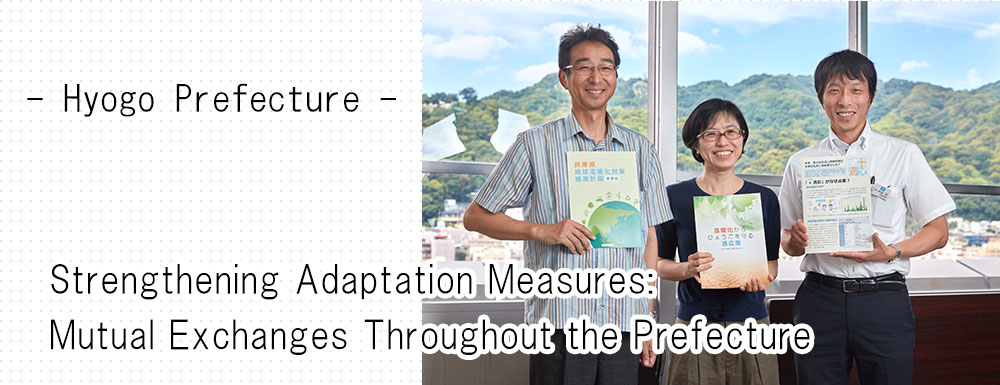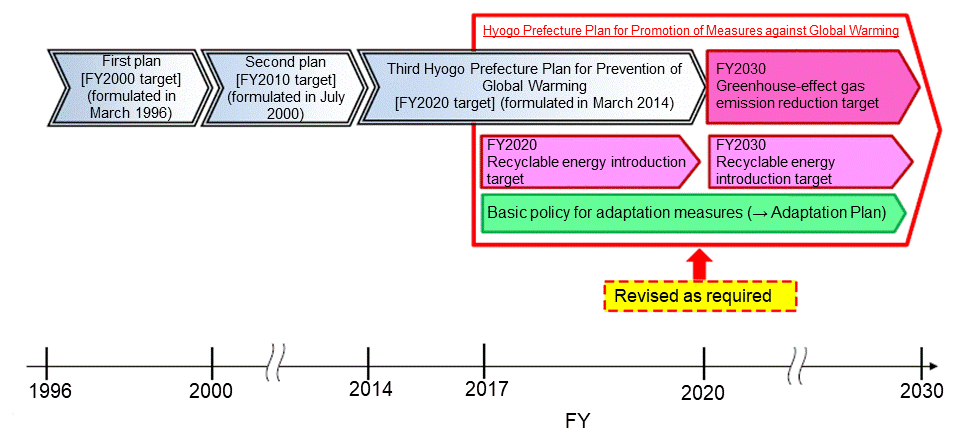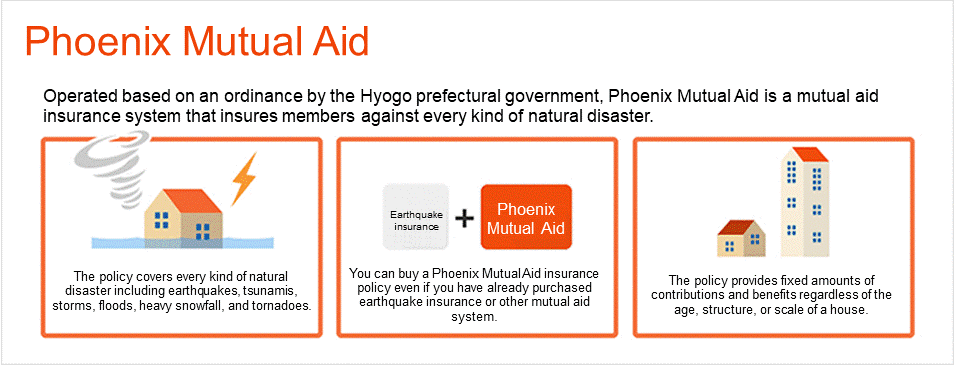Strengthening Adaptation Measures:Mutual Exchanges Throughout the Prefecture

Before the national government’s adaptation plan in March 2017, the Hyogo prefectural government had developed and incorporated adaptation measures into a plan, the result of which was the Hyogo Prefecture Plan for Promotion of Measures against Global Warming. Koji Koshio, Manager of the Global Warming Measures Section; Yo Yoshimura, Assistant Manager of the Section and Promotion Group Leader; and Naoko Nakagawa, Chief Examiner of the Planning Group were interviewed about past and current actions for formulating an adaptation plan and incorporating that plan into the current plan, all of which is scheduled for implementation in 2020.
Start with 15 Lines: Benefitting from Previous Work in Other Prefectures
Why did you decide to position the current plan, Third Hyogo Prefecture Plan for Promotion of Measures against Global Warming, in the category of adaptation measures? How was the plan formulated?

Nakagawa: We were tasked with developing the plan in March 2014. We learned that other prefectures were already involved in the development of adaptation measures, including the Tokyo metropolitan area and Saitama prefecture. Just before we started, someone asked if it was really all right to develop a plan without incorporating work done elsewhere. At that point, we started collecting information from other prefectures. After analyzing this information, we picked three actions that we felt we would be able to achieve. They are (1) systematization of existing measures, (2) establishment of an internal cooperative system, and (3) provision of information. To begin, we selected measures from prefectural government measures that would fit as adaptation measures. The staff in charge then asked the departments in charge to participate in an internal review meeting and to let us include their measures in he measure system table.
Koshio: That was what we did first. The term 'adaptation measure' was unfamiliar to government staff. Only 15 lines of text described the action. That’s all we had to start from.
Nakagawa: This was before the national government formulated an adaptation plan. The number of measures in the list as the outcome of our action was about half of that today. We needed just one piece of paper to show the system.
 The past plans related to global warming measures and the period for the new plan
The past plans related to global warming measures and the period for the new plan You had to get the relevant departments to collaborate despite not knowing much about adaptation measures yourself. This must have been a challenge.
Nakagawa: I had heard that our predecessors spent more than an hour talking to staff in each department. The initial reaction from these discussions was that one or another of the measures was not meant for climate change, but department staff and our predecessors were colleagues in the prefectural government. Our predecessors simply told them, “We plan to systematize the existing measures. Let’s watch how the climate changes in the future and study those changes.” Colleagues in the relevant departments eventually came around and even became close collaborators. At the outset, however, almost none of the departments were ready to move forward with us.
Koshio: Understanding the possible impact of climate change was easier for people if they came from fields related to climate such as agriculture, forestry, civil engineering, or disaster. The reaction in tourism, for example, would be, “How would heat impact tourism?” Our predecessors had to explain ideas that they themselves didn’t yet understand. I cannot imagine how difficult the process must have been for them.
Nakagawa: Neither can I. At first, we had problems selecting appropriate measures among those from the Industrial Labor Department, so we did not incorporate their measures into the measure system table. We asked the Industrial Labor Department to join the internal review meeting, which was established in July 2014. Since then meetings have been held once or twice a year. The sixth review meeting this year was held at the same time as the forum for prefectural residents. Dr. Yasuaki Hijioka with the National Institute for Environmental Studies was a presenter at the forum.
Did you feel that the degree of recognition of adaptation had improved in the government?

Nakagawa: Yes, we did, but when the national government’s adaptation plan was completed that recognition of adaptation increased. That helped us understand the work we had been doing was adaptation measures. There were so many measures that it was difficult for us to even thoroughly read all of them, but we managed. We collated the measures with a variety of general plans from Hyogo prefecture. We then realized that there were still measures not yet included in the system table. When we talked with departmental staff and explained what the national government’s adaptation plan included, staff then easily understood our task.
Hyogo prefecture was selected as one of 11 model local governments in the FY2015 Project for Support to Local Governments about Climate Change Impact Evaluation and Adaptation Planning. How did you feel when you got this support?
Nakagawa: When we were included in this project, we were given information about the other ten governments. We definitely needed that information. We were most grateful when we received information on the other prefectures that had been addressing climate change before we started. In the support project, we were given a fairly detailed chart showing how climate change would impact Hyogo prefecture. If we had to redo the research that had already been done, we would have needed weeks and weeks, perhaps even months.
“Making the Unforeseeable Foreseeable” - Using Disaster Prevention Information
The most significant characteristic of Hyogo prefecture is the discretionary disaster management system, which is not in the national government adaptation plan. No other prefecture has enacted anything like the Hyogo Prefecture Housing Reconstruction Mutual Aid System. How and why did you establish an independent disaster management system?

Nakagawa: One of our coworkers had come from the disaster prevention and management field in 2015 and was very knowledgeable about an area almost unknown to us, namely disaster prevention and management measures, such as how to provide information in a disaster. This knowledge proved key.
Koshio: After the Great Hanshin Awaji Earthquake, Hyogo prefecture led the Union of Kansai Governments in disaster prevention and management activities. These activities required considerable human resources and budget. One aspect the Union of Kansai Governments always considers is how to, as much as possible, reduce unforeseeable events. From their perspective, saying that something was unforeseeable is nothing more than an administrative excuse. The Union had been working to make the unforeseeable foreseeable, improving the disaster prevention and management system. No matter how many structural facilities or measures they develop or take or how many nonstructural measures they take to show they care, the nature of a disaster is that the unforeseeable happens. The Union must have been forced into a situation where it had to establish a safeguard system like Phoenix Mutual Aid to compensate residents when the unforeseeable occurs.
In that sense, the same applies to measures against climate change. As the process of understanding and addressing climate change progresses, that which was once foreseeable will turn out to be unforeseeable. These situations increasingly happen every year. The attitude toward disaster prevention seems precisely the response to climate change. We need to see the unforeseeable. We didn’t create new adaptation measures but rethought existing measures into adaptation measures. This was not an achievement by our Global Warming Measures Section. Rather, what happened is that Hyogo prefecture took measures before other governments did so. We now have a framework of innovative approaches to apply to these adaptation measures, and those measures are reevaluated within that framework.

While the disaster management plan does include unique measures such as the operation of a disaster management system, why did you include the Hyogo Disaster Management Net (Hyogo E Net), a tool to provide information to foreign nationals living in Japan, in the list of adaptation measures?
Koshio: We did this because of a powerful lesson we learned from the Great Hanshin and Awaji Earthquake. Information did not reach those foreign nationals in shelters or affected by the earthquake. Anyone working in administration would find this incredibly sad. After the administration learned about this lack of information the hard way, providing information to people speaking languages other than Japanese became a task for the city of Kobe and Hyogo prefecture. Excluding foreign nationals from that system will not be a problem in the future.
We surveyed prefectural residents last year. One of the questions was “What concerns you most about climate change?” As you might expect, the answer given by the greatest number of respondents was disaster management. The second answer was agricultural produce. These two answers were from an overwhelmingly large number of respondents. The actions taken by the prefecture focused on these two areas.
Workshops to Learn What People Think
We understand you will be holding a Workshop to Survey the Impact of Climate Change through Collaborative Work with Prefectural Residents. What made you think about starting this kind of event?

Nakagawa: In 2015, the Kinki Regional Environmental Office proposed supporting our work. At that time, Professor Nobuo Shiraishi at Hosei University was looking for a venue to hold a workshop on adaptation measures. One idea led to another. We decided to hold workshops at two locations in the prefecture. Residents involved in the environment as well as city and town government officials came to the workshop. After the workshops, we became keenly aware of the varied perspectives and the challenges in helping residents to understand the concept of adaptation. Our new awareness made us realize the importance of encouraging residents' understanding of adaptation and what they think and feel. We wanted to hold a workshop where we could address both understanding of adaptation and feelings. That led to our decision to hold the Survey Workshop. As it is not possible for the prefectural government to conduct future prediction or simulations, we have asked for data from the national government and universities. Until we receive the relevant scientific information, the prefecture can only better understand what residents think and feel. Our prefecture is large. We want to hear the perspectives of residents throughout the prefecture.
Koshio: Even in the same prefecture, we have regional differences in everything from weather to agriculture. Climate change has generated different concerns in those different regions. People in Tajima are concerned about their local agriculture. They wonder if they'll be able to produce and enjoy black soybeans. People in Setouchi are concerned about their fishery industry. They wonder if they’ll be able to market and eat sand lance. Communication is necessary to understand the concerns and the ideas of everyone in the prefecture. Our conclusion was that we needed to promote mutual communication to strengthen understanding of adaptation measures.
Yoshimura: Starting in 2018, we plan to hold workshops at nine locations in the prefecture over the next three years. We believe that participants will gain a deeper understanding of adaptation measures and discuss how they feel the impact of climate change and other concerns they have. In three years, we hope to complete an impact map of the entire prefecture. We need more information from participants at the workshops to create an accurate impact map.
Nakagawa: This year we plan to hold the workshop in three regions: Kobe, Hanshin Kita and Tanba. We would like participants — individuals, administration, and those involved in implementation — to take the lead. Our hope is that participants will discuss the impact on each area and consider what adaptation measures individuals and local communities could take and what the administration and those involved in implementation need to do. These results will ultimately be incorporated into our first adaptation plan.
Informing Residents of the Basics: “If X, We Will Y”
Did you have any problems managing the progress of the Plan for Promotion of Measures against Global Warming?

Koshio: We’re all somewhat reluctant about progress management. That might not be the situation if we could get answers to the problems, but most of the time, we won’t be able to get answers about adaptation measures when we have deadlines to meet. Answering complaints from residents that they won’t be able to produce a certain product next year or that a certain industry is no longer viable and failing to show specific measures to address those complaints would be an exceedingly difficult situation for the prefectural administration. All this means that implementing strict progress management is problematic. Of course, a number of visible results will be achieved. When successful outcomes occur, we will ask each department to disclose as much information as possible. Our adaptation measures are gradually gaining recognition. Although some data cannot be provided because it may be inaccurate or possibly negatively impact an entire industry, much data is now being released. We intend to slowly but steadily expand the concept of adaptation among residents, and we hope to make the process of adaptation orderly and logical so that we are able to monitor future change.
Budget must be a factor when you take these measures. Are there any indices or measurements that secure a budget for adaptation measures for future climate change events?
Nakagawa: None so far. The challenge is budgeting for that which we do not yet know. Providing a cost-benefit analysis with these unknowns cannot be done. Government officials rely on the past because that is the only information they have.
Koshio: The plans we’re talking about today are plans developed before our own plan. They were not created based on the idea of rolling out measures in phases to prepare for future climate change. We are currently asking officials at the highest level in the prefectural government to use internal review meetings or forums to help improve awareness, which means that each department needs to include the perspective of adaptation at the planning stage.
When we develop a plan or implement a budget, the basic stance is “We will do X and Y because Z is happening.” This stance is based on looking at the past, which makes the approach easy to understand. For adaptation, however, the reality is more like “We will do X if Y happens in 10 years, and Z if it happens 20 (the X, Y, Z concept).” The idea is to modify a measure in stages. One of our goals is to realize this approach at the prefectural level. During the stage of shifting to the adaptation plan scheduled for development in 2020 to succeed the next basic policy, any plan we develop — whether for disaster prevention or river and heavy rainfall damage — needs to be based on the X, Y, Z concept. If the plan is not based on the X, Y, Z concept, we will not be able to cope with future climate change. We believe this perspective requires development in Hyogo prefectural government.

Kobe from Awaji Island
Published on December 22, 2017
Related Sites (Update:Octorber 14 2022)

